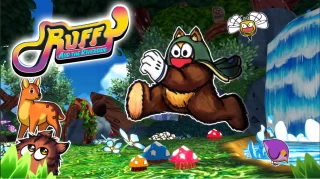In my view, JRPGs post-2000s or so can go about three directions: throwback, anime, or something new. In fact, sometimes they’re a combination of those things. (Xenoblade Chronicles 2, until now undoubtedly the big name among Switch games in the genre, is all three at once, somehow.) While the derision towards the conventions of the genre by some feel a bit trite nowadays, there’s no denying that in the modern age of gaming turn-based random encounters with world-saving plots propelled by six to ten attractive young adults with funky hairstyles can get a bit old — just as there’s no denying that many among us have some rose-tinted longing for the Chrono Triggers, Final Fantasies, and Secret of Manas of old.
Octopath Traveler, from the team behind Bravely Default and Bravely Second, understands this like few games in modern times seem to. Stylistically, it appears to be a radiant take on old JRPGs, complete with pixel art, sonorous theme tunes, and a sprightly collection of protagonists. And yet it also innovates and improves upon the conventions of old, and does all this at a time where that kind of game seems like a relic of a bygone age, ironically appearing fresh in an era where many other titles seem to be afraid to harken back to the past. It’s simultaneously nostalgic and new, and to explain why is our task today.
Eight tales, no epic
Octopath Traveler, true to its amusingly odd title, contains eight protagonists from you to choose from. Unlike your typical plotline, there is no central character, or indeed a central quest — instead, each protagonist embarks upon their own quest, with their own goal, and their own motivation to explore the world of Orsterra. No matter which you start with, you can pick up the rest on your adventure, and experience each of their individual stories at your pace.
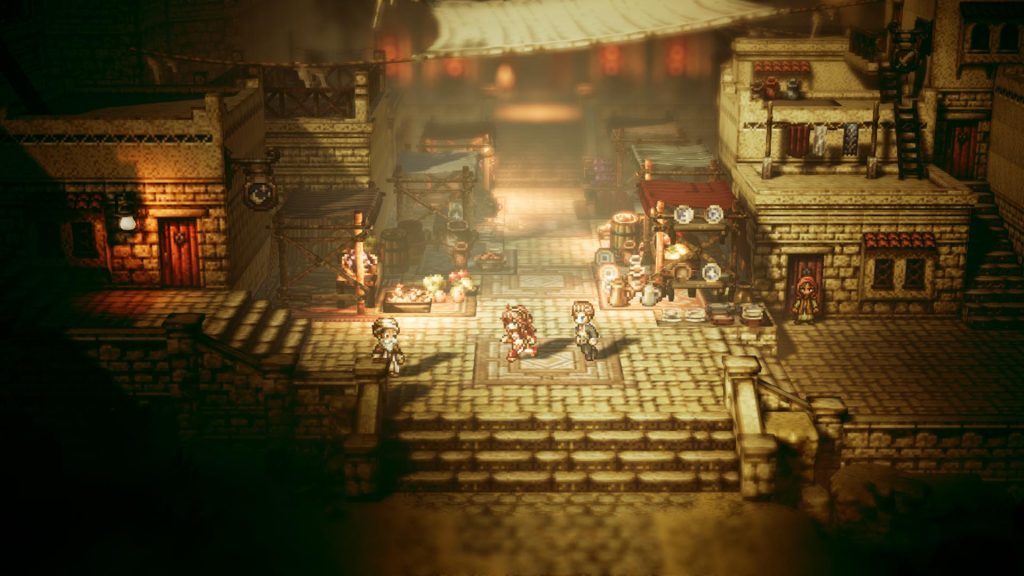
The breadth of stories, both tonally and in scale, is wide. There’s those of vengeance — Primrose’s long quest for revenge on her father’s murderers; Olberic’s search for a traitorous comrade and his own purpose. There’s those of intense peril — H’aanit’s hunt for a dreadful beast and her missing master; Cyrus’s unraveling of a vast infernal conspiracy. There’s those of obligation — Ophilia’s undertaking of her sister’s pilgrimage for the sake of her family, Therion’s pursuit of mystical stones for restoring his own pride. And there’s the simple — Alfyn’s altruistic journey to cure the sick and needy; Tressa’s wandering in search of her own little adventure. As I detailed in my series of demo impressions, each is enticing in its own way.
When I first got my hands on the game, I was concerned that the lack of a central narrative — and much interaction between the various adventurers — would lead to the game being disjointed and unmemorable. What, after all, is the point in having all these characters join forces if not for some greater purpose? It seemed like there had to be something that would cause such a heterogenous group to join up. And the lack of such a thing was a cause for worry.
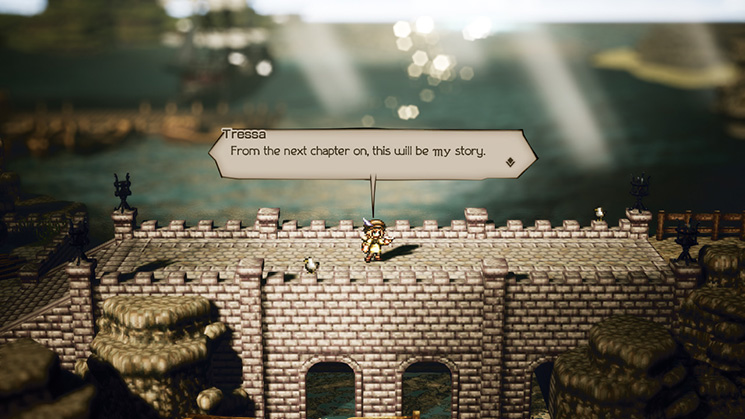
But what I feared would be the game’s greatest weakness has in turn become its greatest strength. After a lifetime of RPGs with large-scale conflicts, where there’s always a doomsday villain and impossibly high stakes at every turn, having a bunch of smaller yet tighter knit personal tales is all I could ever want. I maintain that RPGs are usually at their strongest when focused on smaller character moments and personal growth, due to the genre not allowing for depictions of large scale conflict well (with a few exceptions). Octopath Traveler supports this beautifully, already displaying strong amounts of character development and personal conflict. I’ve only cleared Chapter 2 with each character, but I’ve already seen greater amounts of growth than some bland protagonists receive in entire games, aided by each character getting their own little cast of supporting characters and time in the limelight.
A sentimental stunner
What can be said of Octopath Traveler’s environments other than just ‘wow’? I’ve already heaped praise upon praise for them in my demo impressions, but it bears repeating here — as far as pixel art games go, it is the very best of the best, combining high pixel density, extremely varied and atmospheric lighting, and saturated colors to make the most gorgeous “retro” look possible. From enemy battle sprites (which manage to be exquisitely detailed and even occasionally animated) to the long shadows cast by the game’s torches, almost every second staring at the visuals has left me pleased. Even the non-pixelated world map and character art is stunning — just look at how beautiful each member of the cast is drawn!
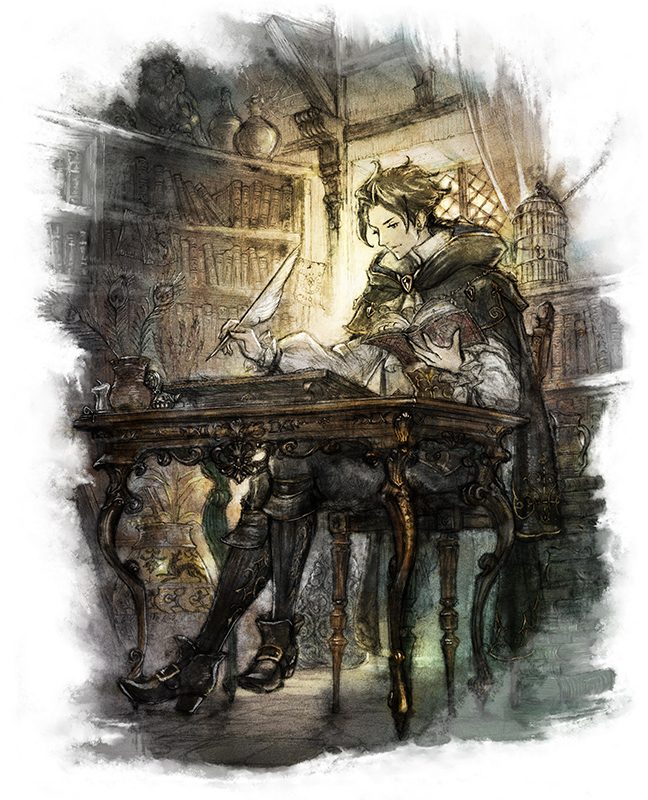
What’s more, the game manages to use this graphical style to craft environments that are well designed. Gone are arbitrary invisible walls and secret passages of old — now, little nooks and throughways are simply woven into the landscape, and you’re awarded for paying attention to alleys instead of blindly stumbling into every wall you see. Usually I can think of one or two little nitpicking things about visual design, but I hesitate to think of even one issue with Octopath, save some exceedingly minor trivialities with the UI which barely bear mentioning.
Not content to deliver a pleasure for only the eyes, OT also provides auditory enjoyment on many levels. The soundtrack is downright sonorous, full of some beautiful wind and orchestral work that can convey sprightly adventure and ominous omens in equal accord. Sound effects are visceral and sharp, with the kreen upon breaking an enemy feeling good no matter how many times it’s done. And the voice acting, while somewhat sparse (only about ⅓ of story cutscenes are fully voiced), is excellent on all fronts, with strong performances from industry veterans that enhance and add layers to each character. Aesthetically, Octopath Traveler proves to be one of the most creative non-indie JRPGs in years, if not decades.
The thrill of a fight
Of course, strong battle mechanics are required for any RPG, and once again Octopath does not disappoint. Battles feel like a natural evolution of Bravely Default and Bravely Second, with a focus on two particular mechanics: Boost and Break. Each turn your character gains one Boost Point, and they can spend BP — up to three at a time — to either add regular attacks to each weapon, or enhance the power of your skills. Using Boost means that you won’t gain BP on the following turn, however. In turn, your enemies have a shield gauge that is depleted when you hit them with one of their weaknesses (based on either a type of weapon or element of spell). When it reaches 0, they Break, and miss both the current and next turns while having their defenses lowered.
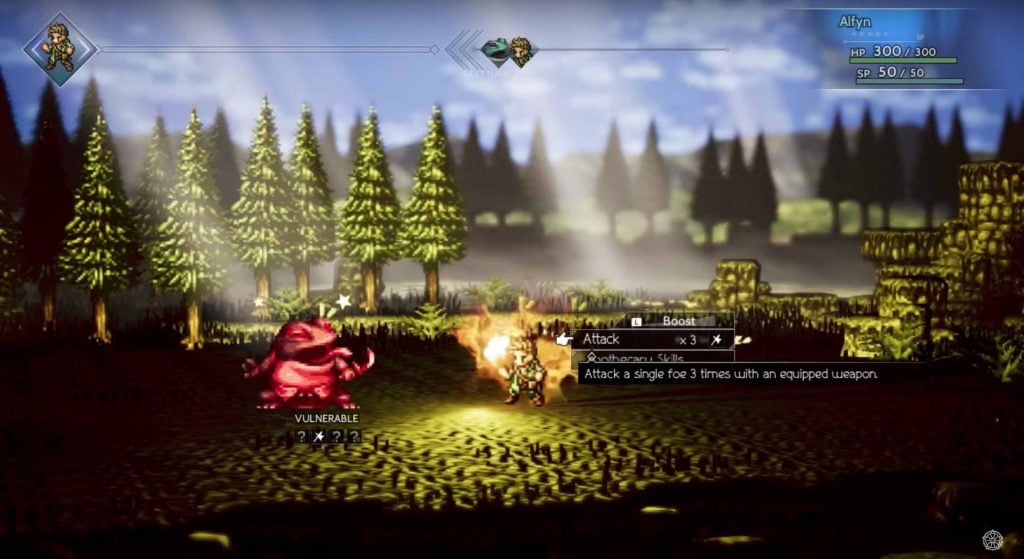
It sounds slightly complex, but is actually rather simple in execution — spend turns chiseling away at the enemy until their defenses Break, and then use all your Boost Points to unleash devastation among them. This basic strategizing gives the battles a lot of texture and variety simply based on enemy weaknesses, as you’ll never be bereft of options to take them down, but your party may be more or less equipped to deal with the situation. It creates moments of decision as well — do you spend Boost now to Break them and stop their attacking, or tough it out so when they do Break you can deal more damage? Combine this with a wide array of character abilities and there’s a solid and textile battle system at play.
Compounding this good design is how each party member serves a particular role. There’s the brawlers (Olberic and H’aanit) who can both dish out and take damage, the casters (Cyrus and Alfyn) who can utilize multiple magic methods, the supporters (Ophilia and Primrose) who focus on tending to other party members, and the utility units (Tressa and Therion) who can attack, support, and suppress in equal accord. Combine this with a balanced spread of weapon types and spells, and you have the making of interesting party setups on your hands, compounded by the game’s job system (which we’ll talk about more next time).
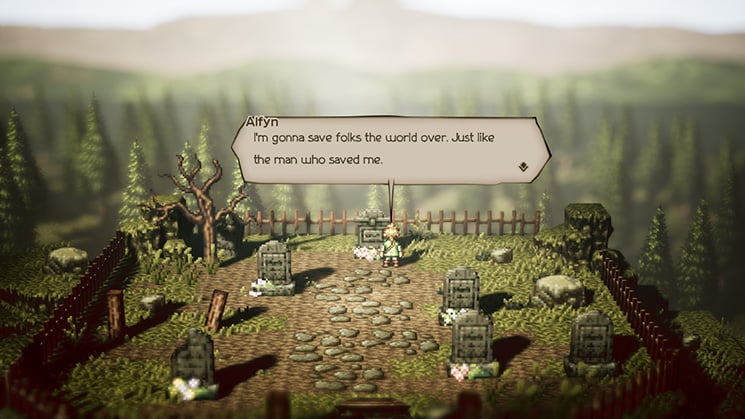
More to come
I’m over 30 hours into Octopath Traveler, and while there’s already so much more I want to say, I’ll hold off until next time. But I think I can confidently say that if you’re even slightly considering getting Octopath Traveler, then you absolutely should. It’s a wonder to play, and I’ve barely scratched the surface of what makes it so good.
Until the next part of our review-in-progress, you can check out our series of demo impressions for thoughts on character stories and other of the game’s miscellany.
Leave a Comment
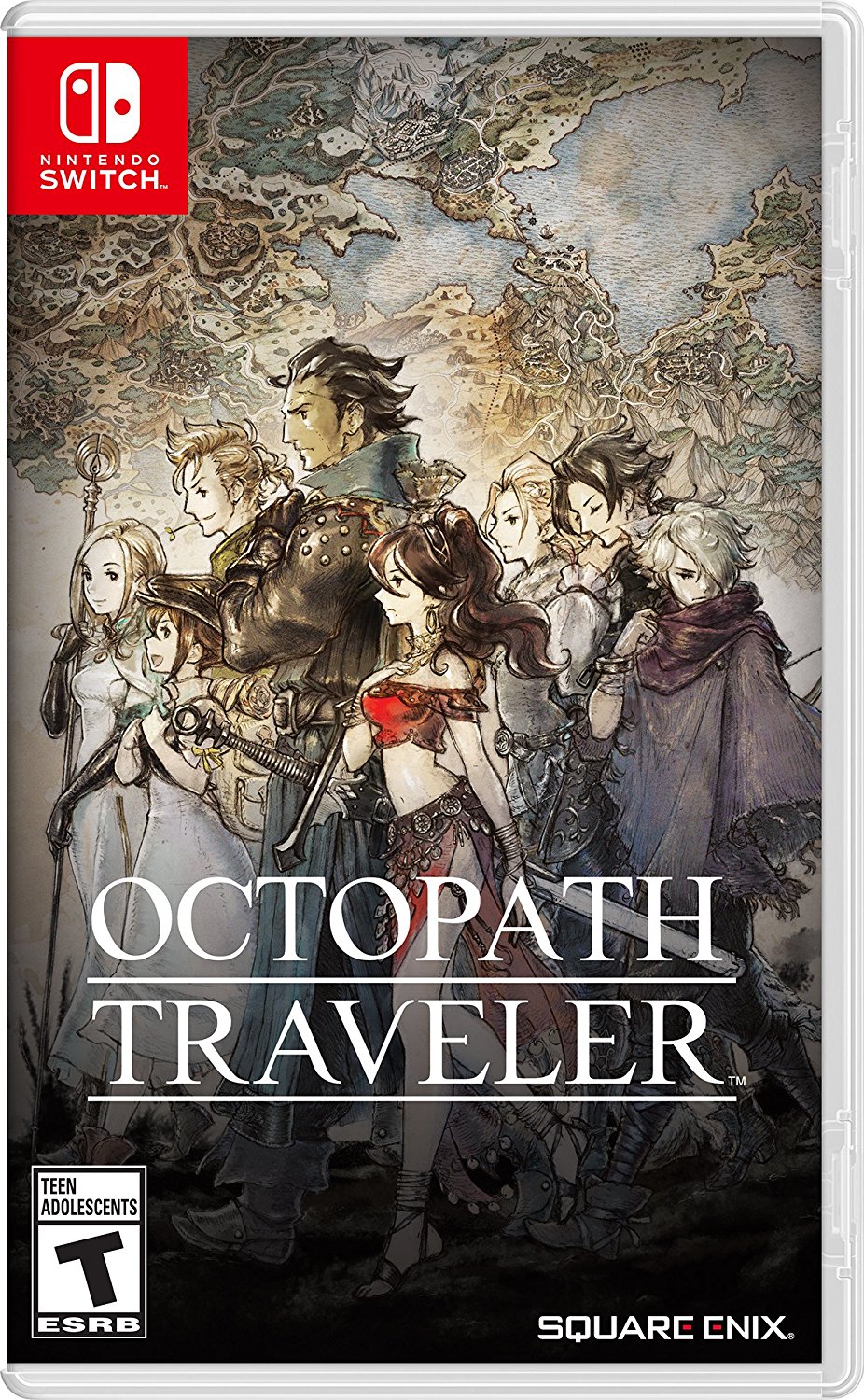
System: Nintendo Switch
Release Date: July 13, 2018
Categories: Role-Playing, Adventure
Publisher: Nintendo
Developer: Square Enix
